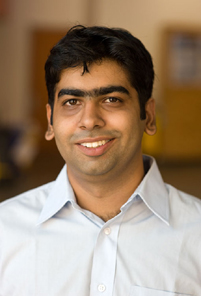This is the latest in a series of profiles of our MIT Energy Fellows — graduate students who are supported by MIT Energy Initiative (MITEI) members to participate in faculty-led research and become part of a long-term community of students and alumni.

By improving the performance of nuclear power plants, Saaransh Gulati hopes to give nuclear energy a boost, thereby helping meet global energy demands while cutting carbon dioxide emissions that contribute to global warming.
Gulati is one of 47 MIT Energy Fellows supported by MITEI’s member companies in 2009-2010. Sponsored by MITEI associate member EDF, Gulati is working with Jacopo Buongiorno, associate professor of nuclear science and engineering, to develop a computational fluid dynamics (CFD) model to predict and improve conditions within nuclear reactors.
The surface temperature of nuclear fuel limits the power production of reactors. Intensely high temperatures can damage the fuel assembly and potentially the core, so identifying the uppermost permitted surface temperature in a light water reactor (LWR)—the most common type of energy-generating reactor worldwide—is of great importance. If the safety and efficiency of the LWR could be pushed higher, more heat could be extracted, and the plant would generate more energy at a lower cost.
Current tools for predicting heat transfer conditions inside reactors make use of over-simplified assumptions, Gulati said. CFD is a computationally intensive way to analyze and solve problems that involve fluid flows. Computers perform millions of calculations to simulate the interaction of liquids and gases with surfaces. Normally, the fuel surface is cooled by water. However, if the heat flux—the amount of heat that flows through a given surface in a given amount of time—exceeds a critical value, the heat transfer from the fuel surface into the coolant deteriorates, resulting in drastically increased fuel surface temperature. Accurate prediction of such conditions by CFD modeling would help reactor designers increase the limits of operating core power densities, making it possible to generate more electricity in LWRs around the world, he said.
Gulati said he has “always been fascinated by fluid mechanics, specifically multiphase flows, because of the complex nature of the mathematics required for describing physical observations.”
In addition to nuclear engineering, flow problems involving water in its liquid and gaseous phases are found in ocean and naval applications, in chemical and other industrial and environmental processes, and in a variety of biomedical applications. Hence, accurate modeling of physical phenomena could provide tremendous insight into the science governing such processes in a wide variety of applications, he noted.
Techno whiz
Growing up in the ancient northern India city Allahabad, Gulati was introduced to his family’s computer business at age 11. “That was precisely the point when my love for technology began. I eagerly used to wait for new computers so that I could fiddle around with them and maybe at times spoil them.” His parents’ indulgence of his “hedonistic technological pursuits” nurtured his budding engineering skill, he said.
Their patience paid off. Gulati gained national and international recognition for his outstanding performance in programming, mathematics, and physics competitions. He aced the Indian Institutes of Technology (IIT) entrance exam and was admitted to IIT Kanpur in his home province of Uttar Pradesh.
As part of a five-year integrated undergraduate-postgraduate program in mechanical engineering, he worked on a wide variety of projects in core engineering disciplines. He specialized in developing techniques for measuring the volume of bubbles in a type of gas-liquid system called a multiphase bubble column—his current research topic at MIT.
“I plan to learn more and more technologies and explore possibilities of interdepartmental research, so I chose the place that has the best possible opportunities around,” Gulati said. “The program has been absolutely awesome. In addition, MIT has given me unbelievable opportunities to learn new technologies and network for entrepreneurial ventures by sharing ideas with some of the brightest minds in the world.”
Atomic energy commissions in both the US and India have predicted that nuclear power will be key to meeting burgeoning energy needs in the coming decades. Gulati hopes that his work will play a major role in providing clean energy for not only the US but also India and other developing countries around the world.